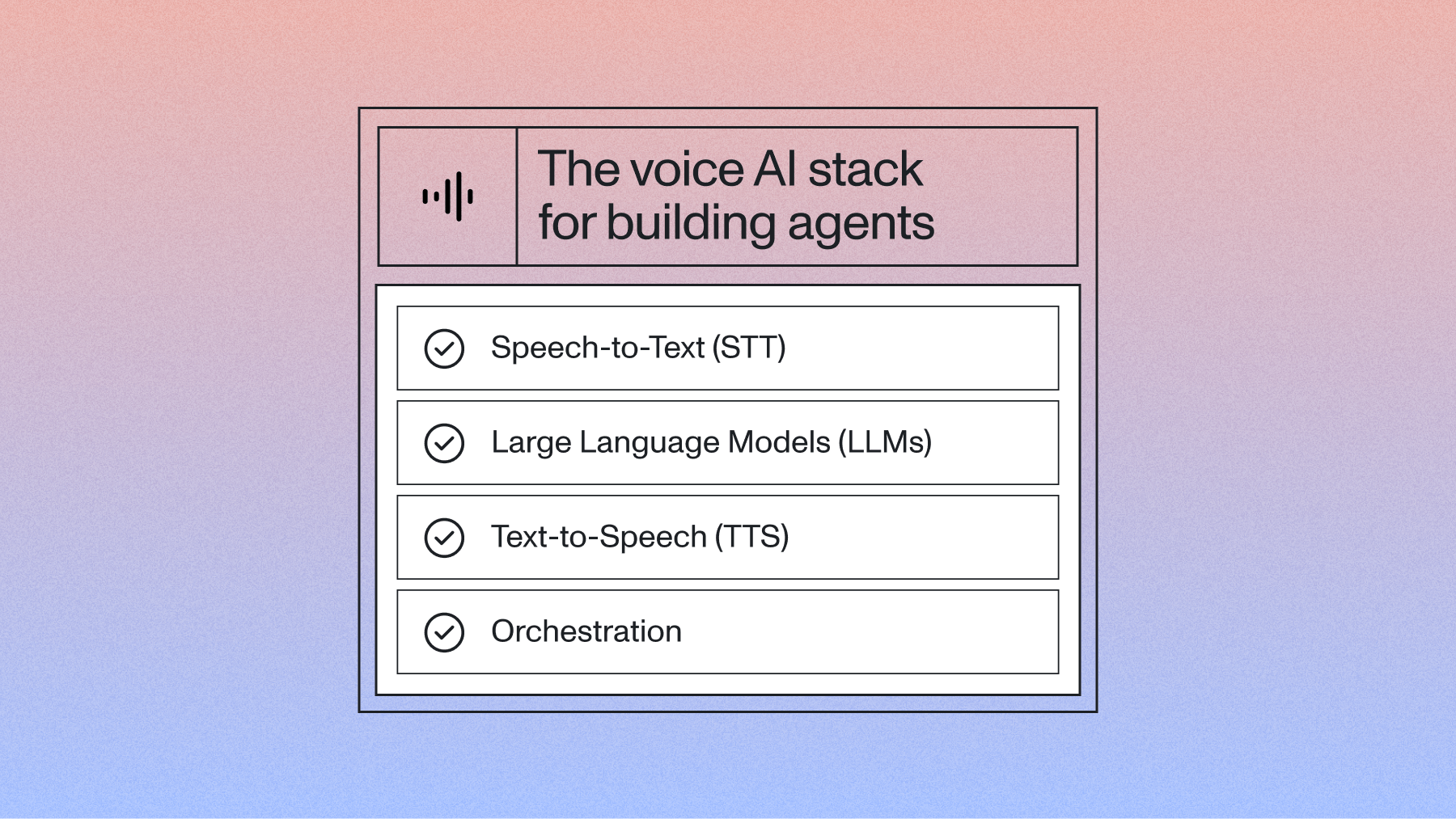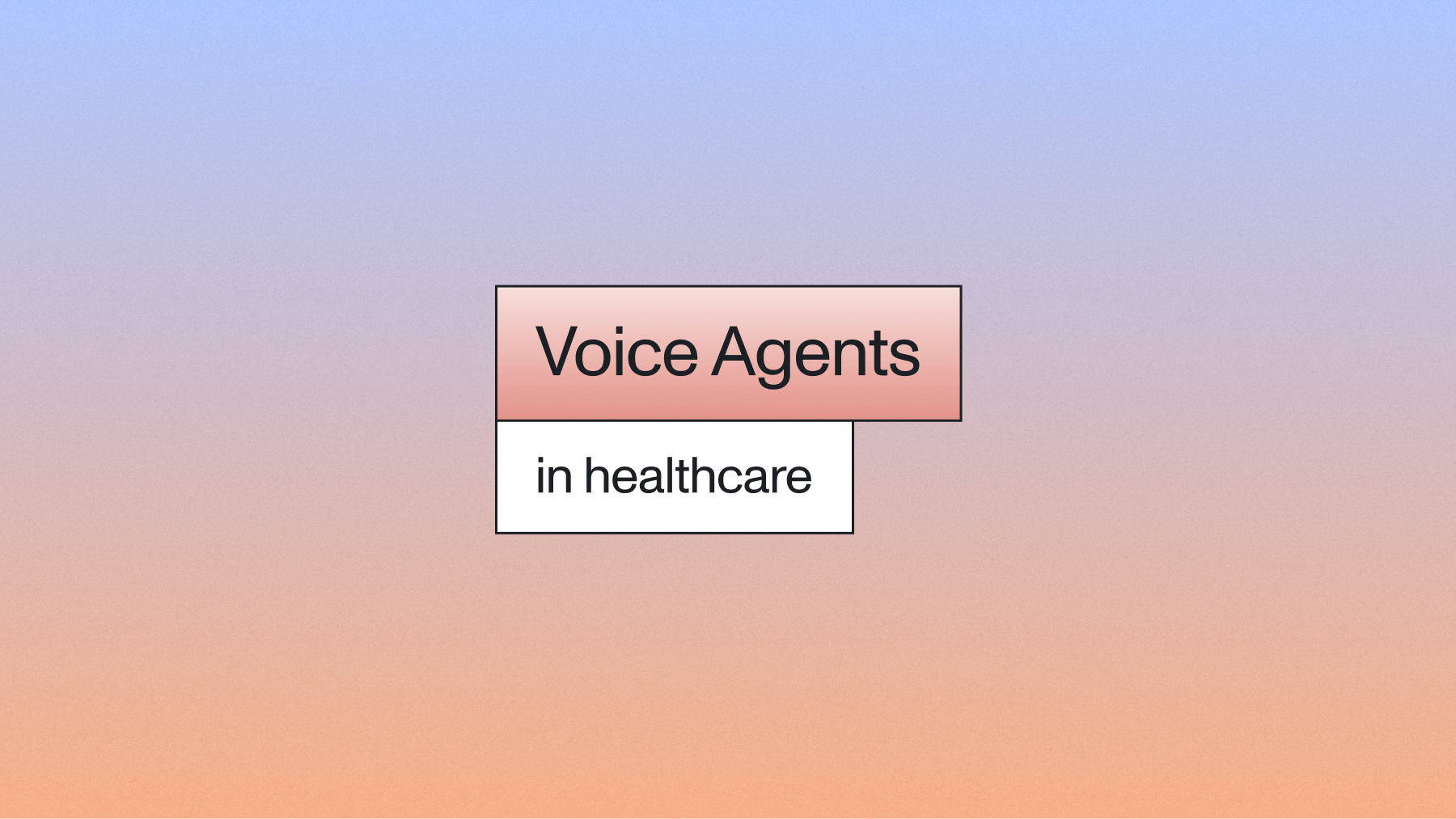The voice AI stack for building agents in 2025
Discover the essential components of the voice AI stack for 2025. Learn about STT, LLMs, TTS, orchestration, and architecture patterns to build effective voice agents.



Voice is rapidly becoming the primary way we interact with AI. By 2025, the shift from typing commands to simply speaking them feels less like science fiction and more like inevitable reality.
The numbers tell a compelling story. Recent industry research shows that 97% of enterprises have adopted voice AI technology, with 67% considering it foundational to their operations. Yet there's a massive gap between what's possible and what's being delivered—only 21% of organizations report satisfaction with their current voice systems.
This disconnect represents an enormous opportunity. While legacy IVR systems frustrate customers with endless menu trees, modern voice AI agents understand natural language, maintain context, and solve problems in real-time. Organizations recognize this potential—98% plan voice AI deployments as early innovators move from experimentation to production.
Building effective voice agents requires understanding the underlying technology stack. This isn't just about connecting an API—it's about orchestrating multiple AI systems to create seamless, human-like interactions. We'll explore the four essential components of the voice AI stack, examine different architectural approaches, and provide guidance for making informed implementation decisions.
Deconstructing the modern AI voice agent stack
Every voice agent relies on four essential pillars working in harmony: Speech-to-Text (STT) as the "ears," Large Language Models (LLMs) as the "brain," Text-to-Speech (TTS) as the "voice," and orchestration as the "conductor" managing the real-time flow between components.
Here's how a typical interaction unfolds:
- User speaks: "Can you help me reschedule my appointment for tomorrow?"
- STT processes: Converts audio to text with proper formatting and punctuation
- LLM understands: Interprets intent, accesses calendar data, generates response
- TTS synthesizes: Converts response text to natural-sounding speech
- User hears: "I can help you reschedule. What time would work better for you?"
This modular approach persists even as end-to-end models emerge. Different components have different optimization requirements. STT needs accuracy and low latency. LLMs require reasoning and context management. TTS demands natural prosody and emotional expression. Specialized models consistently outperform generalist approaches in production environments.
The core challenge is latency. Sequential processing creates cumulative delays—200ms for STT, 500ms for LLM inference, 300ms for TTS synthesis. Those milliseconds add up quickly, turning natural conversation into awkward exchanges where users wonder if their agent is still listening.
Voice AI agent architecture
┌─────────────────────────────────────────────────────────────┐
│ Voice AI Agent Stack │
├─────────────────────────────────────────────────────────────┤
│ User Speech Input │
│ ↓ │
│ ┌─────────────────┐ │
│ │ STT/ASR │ ← Converts speech to text │
│ │ "The Ears" │ (accuracy, latency, endpointing) │
│ └─────────────────┘ │
│ ↓ │
│ ┌─────────────────┐ │
│ │ LLM │ ← Understands intent & generates │
│ │ "The Brain" │ responses (reasoning, context) │
│ └─────────────────┘ │
│ ↓ │
│ ┌─────────────────┐ │
│ │ TTS │ ← Converts text to speech │
│ │ "The Voice" │ (naturalness, latency, emotion) │
│ └─────────────────┘ │
│ ↓ │
│ Audio Response Output │
│ │
│ ┌─────────────────────────────────────────────────────────┤
│ │ Orchestration Layer │
│ │ "The Conductor" │
│ │ • Real-time streaming management │
│ │ • Turn-taking and interruption handling │
│ │ • Conversation state tracking │
│ │ • External API integration │
│ └─────────────────────────────────────────────────────────┘
Speech-to-text (STT): The foundation
STT serves as the critical entry point for voice agents. The "garbage in, garbage out" principle applies heavily here—poor transcription quality cascades through the entire system, leading to misunderstood requests and frustrated users.
Beyond basic accuracy, voice agents need STT systems optimized for conversation. Standard Word Error Rate (WER) metrics don't capture what matters most: proper formatting, correct punctuation, and accurate handling of domain-specific terminology. A system with 90% WER might perform poorly on phone numbers, addresses, or technical terms that are crucial for business applications.
Voice agents demand STT response times under 500ms to maintain natural conversation flow. This means streaming architectures process audio incrementally rather than waiting for complete utterances.
Intelligent endpointing represents another crucial capability. Voice agents need to detect natural speech boundaries—knowing when users have finished speaking versus when they're simply pausing to think. Poor endpointing leads to agents interrupting users or waiting awkwardly long for responses that aren't coming.
AssemblyAI's Universal-Streaming model, for example, offers real-time transcription with ~300ms immutable transcripts at $0.15 per hour, featuring intelligent endpointing optimized for voice agent applications.
The performance demonstrates consistent advantages across the metrics that matter most for voice agents: proper noun recognition, alphanumeric accuracy, and real-world conversation handling.
TTS: Giving voice to AI agents
TTS quality directly impacts user perception and trust. Robotic or unnatural voices immediately signal "artificial" to users, creating psychological barriers that affect engagement and task completion rates.
Modern TTS systems are measured on several key metrics:
Time to First Byte (TTFB) should ideally stay under 200ms for responsive interaction. Streaming TTS architectures can begin audio playback while still generating the complete response. This dramatically improves perceived latency.
Mean Opinion Score (MOS) ratings above 4.0 indicate human-like quality. Recent advances in neural synthesis have pushed commercial systems well into this range. This makes artificial voices nearly indistinguishable from human speech in many contexts.
Emotional expression and prosody add naturalness to responses. Advanced TTS can convey appropriate emotions—empathy when users are frustrated, enthusiasm when sharing positive news, or urgency during time-sensitive situations.
Leading TTS providers like Cartesia, ElevenLabs, and Rime each offer different latency-quality tradeoffs. Cartesia optimizes for ultra-low latency applications. ElevenLabs provides extensive voice customization options. Rime focuses on realistic voices with emotion and proper pronunciation with the greatest focus on quality.
Voice customization allows organizations to maintain brand identity through AI interactions. Custom voices can reflect company personality while still delivering the naturalness users expect from modern voice interfaces.
LLMs: The brain of voice agents
Large Language Models serve as the reasoning engine for voice agents, but their requirements differ significantly from text-based applications. Voice interactions demand faster response times, conversational ability, and seamless integration with external systems.
Latency optimization becomes paramount. While a chatbot user might accept 2-3 second response times, voice conversation feels broken with similar delays. Time to First Token (TTFT) and Time to First Byte (TTFB) metrics matter more than throughput for voice applications.
Conversational ability extends beyond simple question-answering. Voice agents need to maintain context across multiple turns. They must handle interruptions gracefully and adapt their communication style to match user preferences and emotional states.
Function calling capabilities enable agents to interact with external systems—checking calendars, placing orders, or retrieving customer data. The LLM needs to understand when to call functions, format parameters correctly, and incorporate results into natural responses.
Model selection involves balancing capability with latency. Smaller, faster models like GPT-4o or Gemini 2.0 Flash work well for straightforward interactions. Complex reasoning tasks might require larger models despite the latency penalty.
Optimization strategies include prompt engineering for conciseness, response streaming to reduce perceived latency, and intelligent caching for frequently requested information. Some deployments use multiple LLM tiers—fast models for initial processing with handoffs to capable models for complex reasoning.
Orchestration
Orchestration manages the real-time complexity that makes voice agents work seamlessly. This goes far beyond simple data passing between components—it creates natural conversation flow in a fundamentally asynchronous system.
Leading orchestration approaches fall into two categories:
Frameworks like Vapi, LiveKit Agents, and Daily/Pipecat provide building blocks for custom voice agent development. These offer maximum flexibility but require more development expertise.
All-in-One Platforms like Bland, Retell, and Synthflow provide complete voice agent solutions with simplified deployment. These reduce development time but limit customization options for specialized use cases.
Essential orchestration capabilities include:
- Real-time streaming management coordinates audio flow between components while handling network issues, buffer management, and quality adaptation based on connection conditions.
- Turn-taking and interruption handling detect when users want to interrupt the agent. Systems gracefully stop speech synthesis and immediately process new input without losing context.
- Conversation state tracking maintains dialogue history, user preferences, and session context across potentially long interactions spanning multiple topics and function calls.
- External API integration connects voice agents to business systems, databases, and third-party services with proper error handling and fallback strategies.
The choice between frameworks and platforms depends on customization needs versus development speed. Startups often prefer all-in-one solutions for rapid prototyping. Enterprises typically require the flexibility that frameworks provide.
Conversational agent frameworks and end-to-end solutions
Specialized voice agent frameworks abstract away much of the technical complexity while providing voice-specific optimizations. These platforms handle the intricate details of audio processing, real-time coordination, and conversation management.
Development platforms offer comprehensive toolkits for building sophisticated voice agents. They typically include pre-built integrations with major STT, LLM, and TTS providers, conversation design tools, and deployment infrastructure. The focus remains on business logic rather than technical implementation.
Low-code/no-code options enable faster deployment for standard use cases. These platforms provide visual workflow builders, template libraries, and drag-and-drop integration tools. While less flexible than code-based approaches, they significantly reduce time-to-market for common voice agent applications.
Enterprise-focused solutions add advanced capabilities like multi-tenant management, detailed analytics, compliance features, and integration with existing business systems. These platforms often include professional services for custom development and optimization.
End-to-end platforms provide complete voice agent solutions with unified APIs. These simplify integration by handling all stack components internally, though with less flexibility for customization.
Key selection criteria include:
- Integration ecosystem: Native support for preferred STT, LLM, and TTS providers
- Scalability requirements: Concurrent user limits and geographic deployment options
- Customization needs: Ability to modify conversation flow, integrate custom logic, and access low-level controls
- Deployment flexibility: Cloud, on-premise, or hybrid hosting options
- Development team expertise: Technical capability and preferred development approaches
Choosing the right architecture for your voice agent
Two primary architectural patterns emerge for voice agent implementations. Each offers distinct tradeoffs between complexity and performance.
Cascading Pipeline architecture processes each component sequentially. User speaks → STT completes → LLM processes → TTS generates → response plays. This approach is simple to implement and debug but creates cumulative latency that makes conversation feel unnatural. It works well for prototyping or applications where slight delays are acceptable.
All-in-One APIs provide complete voice agent functionality through single endpoints. These platforms handle internal optimization and coordination, offering medium latency with simple integration. However, they limit flexibility for custom requirements or specialized component selection.
Latency contributions vary significantly by component and implementation:
- STT: 100-500ms depending on streaming vs. batch processing
- LLM: 200-2000ms based on model size and prompt complexity
- TTS: 200-800ms influenced by streaming architecture and synthesis quality
- Network overhead: 50-200ms for API calls and audio transmission
Optimization strategies for achieving low-latency performance include:
- Streaming STT with intelligent endpointing reduces transcription latency
- Response streaming from LLMs enables TTS to begin before complete text generation
- Predictive caching pre-computes common responses for instant delivery
- Edge deployment minimizes network latency through geographic proximity
Universal-Streaming provides the foundation for modern streaming architectures with ~300ms transcription latency, intelligent endpointing, and seamless integration with real-time orchestration platforms. This enables voice agents to achieve the natural conversation flow users expect from production systems.
The architectural choice ultimately depends on your specific requirements:
- Choose Cascading for production systems, customer-facing applications, or anywhere natural conversation is essential
- Choose All-in-One for rapid deployment, standard use cases, or teams with limited voice AI expertise
Final words
Voice AI represents a fundamental shift in how humans interact with technology. The stack we've explored—STT, LLMs, TTS, and orchestration—forms the foundation for this transformation, but success lies in the thoughtful integration of these components.
The opportunity is massive. As enterprises recognize voice as the primary interface for AI interaction, those who master the underlying technology stack will build the applications that define the next decade of human-computer interaction.
AssemblyAI's Speech AI models provide the reliable foundation voice agents require. Voice AI agents represent how we'll interact with AI systems moving forward.
The future is conversational. Make sure you're ready to be part of it.
Lorem ipsum dolor sit amet, consectetur adipiscing elit, sed do eiusmod tempor incididunt ut labore et dolore magna aliqua. Ut enim ad minim veniam, quis nostrud exercitation ullamco laboris nisi ut aliquip ex ea commodo consequat. Duis aute irure dolor in reprehenderit in voluptate velit esse cillum dolore eu fugiat nulla pariatur.





